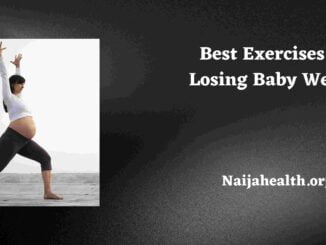
Best Exercises For A Smaller Waist
Having a smaller waist is the goal of many people who want to improve their overall figure and achieve a fit figure. While genetics and body composition play an important role in waist circumference, incorporating targeted exercises into your exercise routine can help you achieve a slimmer waistline.
In this article, we’ll explore the best exercises for a smaller waistline, with a focus on both core strength training and cardio. We’ll discuss the benefits of waist training, the role your core plays in achieving a smaller waistline, and how a strong core can improve your posture and body shape.
8 Best Exercises for Smaller Waist
When it comes to targeting and toning your waistline, here are the eight best exercises that can help you achieve a smaller waistline:
- Crunches
- Lie on your back, knees bent and feet flat on the floor.
- Place your hands behind your head or on your chest.
- Focus on your center of gravity and lift your upper body off the ground, bringing your chest toward your knees.
- Lower back with control and repeat for desired number of repetitions.
- Focus on contracting the abdominal muscles throughout the movement.
- Crunches when cycling
- Lie on your back, bend your knees and place your hands behind your head.
- Lift your feet off the ground, bringing your knees toward your chest.
- Straighten your left leg while twisting your upper body, bringing your right elbow toward your left knee.
- Alternate sides, mimicking the pedaling motion while maintaining your core activity.
- Planks
- Start in a push-up position, leaning on your forearms instead of your hands.
- Focus on your core and maintain a straight line from head to toe.
- Hold this position for the desired amount of time, focusing on keeping your abs tight and avoiding slipping or arching your back.
- Side plank
- Lie on your side with your forearms on the floor, elbows in line under your shoulders.
- Raise your hips off the floor to create a straight line from head to toe.
- Focus on your core and hold this position, making sure your body stays aligned.
- Repeat on the other side.
- Russian twist
- Sit on the floor with your knees bent and feet slightly lifted off the floor.
- Lean back slightly, maintaining a straight back and active center of gravity.
- Rotate your torso to the right by bringing your arms or dumbbells to the right side of your body.
- Turn to the left, move the dumbbell or hand to the left. Continue to switch sides in a controlled manner.
- Mountain Climbers
- Start in a high plank position with your hands just below your shoulders.
- Bring one knee to your chest, then quickly switch legs.
- Move your legs back and forth in a running motion while keeping your core active.
- Maintain a fast and controlled pace.
- Side bend
- Stand up straight, feet hip-width apart, hands on hips or clasped behind head.
- Slowly bend to the right, keeping the upper body aligned and the center of gravity active.
- Return to the starting position and repeat the bend to the left.
- Focus on feeling the stretch along your side waist while maintaining good posture.
- Waist circles
- Stand with your feet shoulder-width apart and place your hands on your hips.
- Slowly rotate your hips in a circular, clockwise or counter-clockwise motion.
- Focus on your core and maintain stability throughout the movement.
- After a few laps in one direction, go in the opposite direction.
Understanding Waist Training and Core Muscles
Waist training involves the use of exercises and sometimes special clothing to reduce the waistline and strengthen the abs. Your core muscles include the rectus abdominis (“six pack”), the obliques on the sides of the waist, the transverse abdominis (the deep muscle that wraps around the abdomen), and the multifidus (the small muscles on the sides of the abdomen).
To get the best results from waist workouts, you need to properly engage these core muscles. Use proper form and technique to avoid injury and make the exercise effective. Keep your body in alignment, breathe properly, and gradually increase the difficulty of the exercise as you get stronger.
Waist training may also include wearing a corset to compress the waist and support the abs. However, be careful and do not use these clothes excessively as they can have adverse effects on health.
For best results, combine targeted exercise with cardiovascular exercise and a healthy diet. This will help you lose body fat, strengthen your abs, and reduce your waistline. You should consult with a fitness professional or healthcare provider to create a waist training program that’s right for your goals and needs.
Safety Considerations for Best Exercises for Smaller Waist
Safety should always be the first priority when performing exercises, including those aimed at reducing size.
Here are some important security considerations to keep in mind:
- Correct form and technique
- Firmly grasp and keep the correct form and technique for each exercise. Improper form can lead to injury and reduced training effectiveness.
- Seek advice from a fitness professional or qualified trainer to learn the correct form for each exercise.
- Gradual progression
- Start at a level appropriate for your current fitness level and gradually increase the intensity or difficulty of the exercise over time.
- Avoid overexerting yourself or trying advanced variations before you’re ready, as this can lead to muscle strain or other injuries.
- Warm up and cool down
- Always warm up with dynamic stretches or light cardio before you start working out to prepare your muscles and joints.
- End your workout with a cool-down phase, which includes static stretching, to promote muscle recovery and prevent post-workout soreness.
- Listen to your body
- Pay attention to your body’s signals and listen for any pain, discomfort, or fatigue.
- If you experience severe or persistent pain, stop exercising and consult your doctor.
- Individual limitation and modifications
- Consider any pre-existing medical conditions, injuries, or physical limitations that may affect your ability to perform certain exercises.
- Modify exercises as needed to accommodate your limitations, such as doing a knee crunch instead of a full bend if you have lower back problems.
- Rest and recovery
- Give your body enough time to rest and recover between workouts.
- Overtraining can lead to fatigue, decreased performance, and increased risk of injury.
- Hydration and breathing
- Stay well hydrated before, during and after your workout.
- Breathe properly while performing the exercises, make sure not to hold your breath as this can lead to wasted effort.
- Personalized approach
- Realize that everyone’s body is different and what works for one person may not work for another.
- Tailor your exercise routine to your personal needs and goals, and seek professional advice if needed.
FAQs
Can I reduce waist fat with specific exercises?
While targeted exercises can strengthen and tone your waist muscles, they cannot directly reduce fat in this area. To lose body fat, including around the waist, you need a combination of regular exercise, a balanced diet, and cardiovascular exercise.
How long will it take to see results on my waistline?
The time frame for seeing results varies from person to person, depending on factors such as genetics, body composition, exercise and diet consistency. With dedication and a well-rounded fitness routine, including exercises that target the waistline, cardiovascular exercise, and a healthy diet, you can start to notice changes in your waistline within a few weeks to a few months.
Do waist trainers or corsets work to train the waist?
Waist trainers or corsets can provide temporary compression and support to the waist, which can create the appearance of a smaller waist. However, they are no substitute for proper exercise and a healthy lifestyle. Excessive or prolonged use of corsets can cause negative health effects and does not lead to long-term size reduction.
Are there any risks or precautions I should be aware of when doing exercises that target the waistline?
It is essential to prioritize safety when participating in exercises that target the waistline. Some precautions to keep in mind include staying in good physical condition, avoiding overexertion or soreness, and gradually increasing the intensity of your exercise over time. If you have any pre-existing conditions or health concerns, consult your healthcare practitioner before starting a new exercise program.
Can I have a smaller waist without exercise?
While exercise plays an important role in achieving a smaller waistline and improving overall body composition, it is not the only determining factor. A balanced, calorie-controlled diet and healthy lifestyle also help reduce body fat and achieve a smaller waistline. Combining both exercise and a nutritious diet will bring the best results.
Are there any specific exercises to avoid for a smaller waist?
Exercises that put undue stress on the lower back, such as crunches or twists with heavy weights, should be avoided. These exercises can increase your risk of injury. It is important to listen to your body and avoid any exercise that causes discomfort or pain.
Conclusion
Achieving a smaller waistline involves a combination of targeted exercises, core muscle engagement, and a holistic approach to fitness and health. Exercises such as sit-ups, cycling sit-ups, planks, side plans, Russian twists, rock climbing, side bends, and waist twists can help tone and tone your waistline.
It’s important to prioritize safety during exercise by maintaining proper form and technique, gradually increasing the intensity, and listening to your body. You should consult with a fitness professional or healthcare provider, especially if you have any pre-existing conditions or concerns.
Approaches to waist training with caution and the use of tight-fitting garments such as corsets or corsets should be done in moderation, understanding their limitations and potential risks.



Be the first to comment